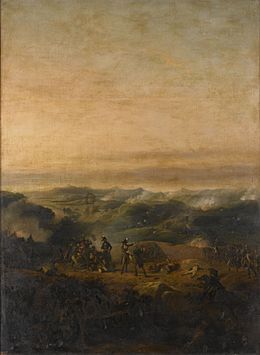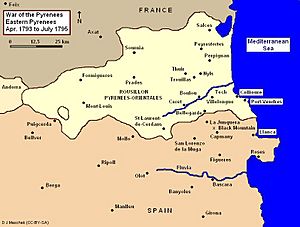Battle of the Black Mountain facts for kids
Quick facts for kids Battle of the Black Mountain |
|||||||
|---|---|---|---|---|---|---|---|
| Part of the War of the Pyrenees | |||||||
 Death of General Dugommier at the Battle of the Black Mountain, painted between 1834–1837 |
|||||||
|
|||||||
| Belligerents | |||||||
| Commanders and leaders | |||||||
| Strength | |||||||
| 25,000 | 50,000 | ||||||
| Casualties and losses | |||||||
| 3,000 killed and wounded | 10,000 killed and wounded 8,000 captured |
||||||
The Battle of the Black Mountain was a major fight during the War of the Pyrenees. It happened from November 17 to 20, 1794. The battle is also known by other names like Capmany, Sierra Negra, Del Roure, or Montroig.
In this battle, the army of the First French Republic fought against the combined armies of Spain and Portugal. The French army, led by Jacques François Dugommier, won against the Allies, who were commanded by Luis Firmín de Carvajal, Conde de la Unión.
Both main commanders died during the battle. A Spanish cannonball killed General Dugommier early on. Dominique Catherine de Pérignon then took charge of the French army. Later, de la Union was shot while leading a cavalry attack. Jerónimo Girón-Moctezuma, Marquis de las Amarilas temporarily replaced him. The French victory helped them capture the city of Figueres and later lay siege to the port of Roses in Catalonia, Spain.
Contents
Background to the Battle
In 1793, the Spanish army had some victories, like at the Siege of Bellegarde and the Battle of Truillas. These wins allowed Spanish forces to take over parts of Roussillon, an area in France near the border with Spain by the Mediterranean Sea.
On January 16, 1794, a new French general named Jacques François Dugommier took command of the French army in the Eastern Pyrenees. He was famous for winning the Siege of Toulon. General Dugommier quickly made the army stronger. He gathered supplies, built weapons factories, set up hospitals, and improved roads. By April, his main fighting force had 28,000 soldiers. Another 20,000 troops guarded areas, and 9,000 new volunteers joined them.
General Dugommier organized his army into different groups, or divisions. These were led by Generals Dominique Catherine de Pérignon, Pierre Francois Sauret, and Pierre Augereau. There was also a cavalry (horseback soldiers) group. In late April 1794, Dugommier launched his attack. The French won the Battle of Boulou on May 1. This forced the Spanish army to retreat south of the Pyrenees mountains. The French then took back Collioure on May 29. General Pérignon also won a fight at La Junquera on June 7. Later, General Augereau stopped a Spanish attack at the Battle of San-Lorenzo de la Muga on August 13. A long siege of Fort de Bellegarde ended on September 17, with the Spanish surrendering.
The Battle Begins
Battle Plans
To protect important places like Figueres and Roses, the Spanish commander, Luis Firmin de Carvajal, Conde de la Union, built a strong defense. He set up 90 small forts, called redoubts, in a long line. The Spanish army included very good soldiers, like those from the Spanish Guard and Walloon Guard Regiments. There were also less experienced troops, such as local militia.
The Spanish also had help from a Portuguese army division. This group included soldiers from several infantry (foot soldier) regiments.
General Dugommier planned his attack with about 36,000 French troops. About 22,000 of these were in the first attack line. General Augereau's group had 9,000 men on the western side. General Pérignon's 8,700 soldiers were in the middle. General Sauret's 4,300 troops were on the eastern side. The French also had more soldiers in a second line, a third line, and a reserve group.
De la Union had about 45,000 soldiers to defend his forts. This included 10,000 soldiers in a second line ready to help. On the western side, Lieutenant General Juan de Courten had 10,000 troops defending areas like Sant Llorenç de la Muga. On the eastern side, Lieutenant General Juan Miguel de Vives y Feliu had 12,000 men. In the center, Lieutenant General Jerónimo Girón-Moctezuma, Marquis de las Amarilas commanded 23,000 soldiers.
First Attacks
General Dugommier sent his French divisions forward on the night of November 16, 1794. General Augereau attacked on the right side. General Pérignon moved forward in the center, with cavalry support. Generals Sauret and Claude Perrin Victor made smaller attacks on the left side to distract the Spanish.
Augereau's attack on the cannon factory in Sant Llorenç de la Muga was successful. This forced the Spanish to pull back their troops. However, attacks by Pérignon in the center and Sauret on the left did not succeed. They faced very strong Spanish cannon fire. A group of Spanish cavalry and foot soldiers even broke through Sauret's line for a short time. But French reinforcements pushed them back.
On the morning of November 18, General Dugommier was watching the battle from a hill called Montroig. Spanish cannons fired at the French position. Around 7:30 AM, an artillery shell exploded near him. A piece of the shell hit him, and he died.
The Final Push
After General Dugommier's death, General Pérignon took over command. He stopped the attack for a short time. On November 18 and 19, the French leaders met to decide what to do next. Pérignon decided to attack from the northwest, through a valley near Montroig.
The new attack started at dawn on November 20. The French troops broke through the Spanish first and second lines of defense. French soldiers then began to attack a fort with 25 cannons at the Santa-Maria-del-Roure monastery. This fort was about 2 kilometers (1.2 miles) northwest of Pont de Molins.
The fighting was very tough. Spanish defenders fired intensely, breaking the French into smaller groups. But the French kept attacking for three hours. Finally, the French managed to surround the fort, and it fell around 3:00 PM.
While this was happening, de la Union, the Spanish commander, was at his headquarters. He heard that the Santa-Maria-del-Roure fort had fallen. He quickly rode to the front lines. Near Pont de Molins, he led a counterattack with 1,300 cavalry soldiers. During this fight, de la Union was hit by two bullets and died. He fell about 300 meters (328 yards) from the Santa-Maria-del-Roure fort.
After de la Union's death, the Spanish left side retreated. An isolated group of 2,000 Spanish troops also retreated to Figueres. They joined the 7,000 soldiers guarding the San Fernando Fortress there. Many wounded soldiers also took shelter in the fortress. De las Amarilas took command of the Spanish army, which was very shaken. He marched them toward Girona, leaving a small group to cover their retreat.
After the Battle
During the Battle of the Black Mountain, the French army had about 3,000 soldiers killed or wounded out of 35,000 who fought. The Spanish and Portuguese armies lost about 10,000 soldiers killed, wounded, or missing out of 50,000 men. The French also captured 30 Spanish cannons.
The French army quickly took control of Figueres. But the strong San Fernando Fortress, which was just northeast of the city, still held out. On November 27, General Pérignon tricked the fortress commander into surrendering. The entire group of 9,000 soldiers and 171 cannons in the fortress fell into French hands.
In December, de las Amarilas was removed from command. This was because he had abandoned San Fernando and made mistakes in earlier battles. Lieutenant General José de Urrutia y de las Casas then took command of the Allied army. The next big actions in the eastern Pyrenees were the Siege of Roses, which lasted until February 1795, and the Battle of Bascara in June 1795.
Images for kids
See also
 In Spanish: Batalla del Roure para niños
In Spanish: Batalla del Roure para niños






